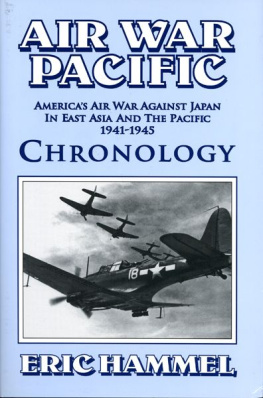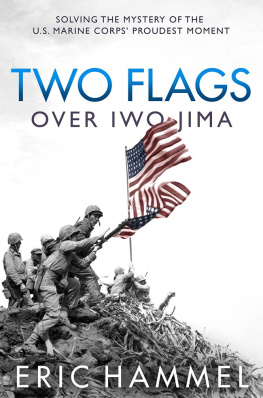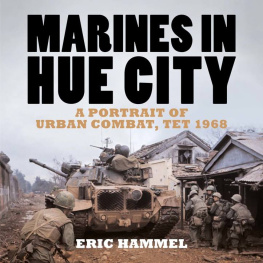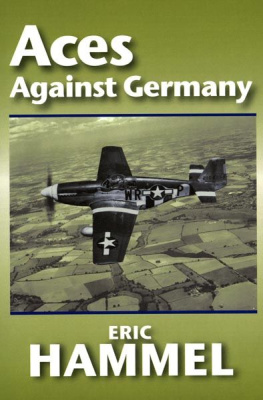Authors Note
O n August 7, 1942, eight months to the day following the Japanese attack on Pearl Harbor, the United States struck back against the empires Pacific juggernaut with an ill-planned amphibious assault at Guadalcanal by the undertrained 1st Marine Division. Although the Anglo-American war plan called for the defeat of Germany foremost, news that a Japanese airfield was under construction in the Eastern Solomon Islands was too provocative to ignore; aircraft that would soon operate from the new airfield would threaten the vital sea lanes connecting the U.S. mainland to the principal Allied Pacific base and war depot in Australia. The stakes were high for the first major Allied offensive in the Pacific, and the 1st Marine Divisions four-and-a-half-month stand on Guadalcanal was a cliffhanger, but the Marines defeated the Japanese army in one close-run action after another.
The American victory at Guadalcanal was followed by the commitment of several Marine battalions to the U.S. Army-run New Georgia campaign, and Marine Corps aviation came into its own during the year-long Allied advance from Guadalcnal through the Central Solomon Islands. The 3d Marine Division invaded Bougainville on November 1, 1943, and the 1st Marine Division went into action again in western New Britain in late December 1943. Also by late December, Marine Air had become the preponderant force in the air assault on Japans regional fortress at Rabaul, in eastern New Britain. Meanwhile, the Guadalcanal-tested 2d Marine Divisions unexpectedly bloody assault at Tarawa, in the Central Pacifics Gilbert Islands in late November 1943 was followed in January and February by the 4th Marine Divisions relatively easy victory at Kwajalein Atoll in the eastern Marshall Islands and the independent 22d Marine Regiments three storm landings in Eniwetok Atoll in the western Marshalls.
Marine infantrymen and airmen traveled a long and difficult road from Guadalcanal through the Marshalls. The island campaigns of 1942, 1943, and early 1944 forged four combat-tested divisions that provided veterans around whom two additional divisions were to be formed.
*
During the first year of the Pacific War, the Marine Corps devoted few resources to documenting the war on film. Very few photographers were deployed to the Pacific through the late summer of 1943, and they were not trained nor often called upon to act as combat photographers. That worldview, the name, and the training to go with it, did not emerge in the field until late 1943, at Bougainville, Cape Gloucester, and Tarawa.
The photographic record visibly perked up at both Bougainville and Tarawa as more and better-organized photographers with a better idea about what to photograph moved into battle with Marine combat units. This later photographic record is much larger and visibly mounts in intensity as one follows the Marines across the wide Pacific. The photos are of better quality, more immediate, more sympathetic toward the combat Marines who have to assault the beaches, brave the fire, take the hills, comb the valleys and forests, and reduce all manner of Japanese defensive schemes that mark the long, long road to victory. The photos become more knowing and more in-sightful as the photographers begin to share the day-to-day, moment-by-moment, life-and-death struggles their combatant comrades are thrown into. Indeed, as the photographers got more battle experience under their own belts, they became more hardbittenmore fatalistic and less cautious, yet more willing to come to grips with the many faces of war that expressed themselves all around them as other young men fought and died on the shared battlefield, in the shared state of privation. That will be evident as you encounter the photographic record in this volume.
Eric Hammel
Northern California
Fall 2012
Books by Eric Hammel
76 Hours: The Invasion of Tarawa (with John E. Lane)
Chosin: Heroic Ordeal of the Korean War
The Root: The Marines in Beirut
Ace!: A Marine Night-Fighter Pilot in World War II (with R. Bruce Porter)
Duel for the Golan (with Jerry Asher)
Guadalcanal: Starvation Island
Guadalcanal: The Carrier Battles
Guadalcanal: Decision at Sea
Munda Trail: The New Georgia Campaign
The Jolly Rogers (with Tom Blackburn)
Khe Sanh: Siege in the Clouds
First Across the Rhine (with David E. Pergrin)
Lima-6: A Marine Company Commander in Vietnam (with Richard D. Camp)
Ambush Valley
Fire in the Streets
Aces Against Japan
Aces Against Japan II
Aces Against Germany
Air War Europa: Chronology
Carrier Clash
Aces at War
Air War Pacific: Chronology
Aces in Combat
Bloody Tarawa
Marines at War
Carrier Strike
Pacific Warriors: The U.S. Marines in World War II
Iwo Jima: Portrait of a Battle
Marines in Hue City: Portrait of an Urban Battle
The U.S. Marines in World War II: Guadalcanal
The U.S. Marines in World War II: New Georgia, Bougainville, and Cape Gloucester
The U.S. Marines in World War II: Tarawa and the Marshalls
The Forge
Coral and Blood
The Road to Big Week
Islands of Hell
Always Faithful
The Steel Wedge
Marines On Okinawa
Marines In the Marshalls
Marines On Peleliu
Marines On Guadalcanal
Marines In the Solomons
Marines On New Britain
Contents
Text Copyright 2012 by Eric Hammel
Book Design and Layout Copyright 2012 by Words To Go, Inc.
All Maps Copyright Meridian Mapping
All rights reserved. No part of this publication may be reproduced or transmitted in any form or by any means, electronic or mechanical, including photocopy, recording, or any information storage and retrieval system, without permission in writing from the publisher.
Requests for permission to make copies of any part of the work should be mailed to: Permissions, Pacifica Military History, 1149 Grand Teton Drive, Pacifica, California 94044.
ISBN-10: 1-890988-62-6
ISBN-13: 978-1-890988-62-3
Book Design and Type by Words To Go, Inc., Pacifica, California
Cover Design by Tom Heffron, Hudson, Wisconsin
Maps by Meridian Mapping, Minneapolis, Minnesota
***
For a complete listing of all the military history books written by Eric Hammel and currently available in print or as ebooks, visit: http://www.EricHammelBooks.com A free sample chapter from each book is available in the sites Free section.
Please also visit http://www.PacificaMilitary.com
This book is respectfully dedicated to the gallant American soldiers, sailors, airmen, and Marines who stood their ground and achieved the stunning victory in the Pacific
Glossary and Guide to Abbreviations
IIIAC III Amphibious Corps
VAC V Amphibious Corps
Amtrac Amphibian tractor
B-24 U.S. Army Air Forces Consolidated Liberator four-engine heavy bomber
B-29 U.S. Army Air Forces Boeing Superfortress four-engine very-heavy bomber
BAR U.S..30-caliber Browning automatic rifle
Bazooka U.S. 2.36-inch antitank/antiemplacement rocket launcher
Corsair U.S. Navy/Marine Vought F4U single-engine fighter
CVE Escort aircraft carrier
D-day Invasion day
D+1, etc. The day after D-day, etc.
DUKW U.S. wheeled amphibian truck
F4U U.S. Navy/Marine Vought Corsair single-engine fighter
GI Government issue; slang for a U.S. Army soldier
HVAR High-velocity aerial rocket
LCI(G) Landing craft, infantry (gunboat) armed with 20m and 40mm cannon
LCI(R) Landing craft, infantry (rocket) armed with rockets

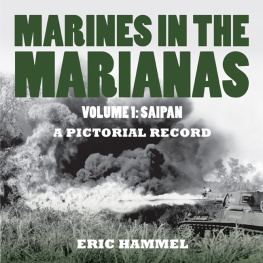

![Hammel - The artists guide to GIMP effects creative techniques for photographers, artists, and designers ; [covers GIMP 2.8]](/uploads/posts/book/138245/thumbs/hammel-the-artist-s-guide-to-gimp-effects.jpg)
